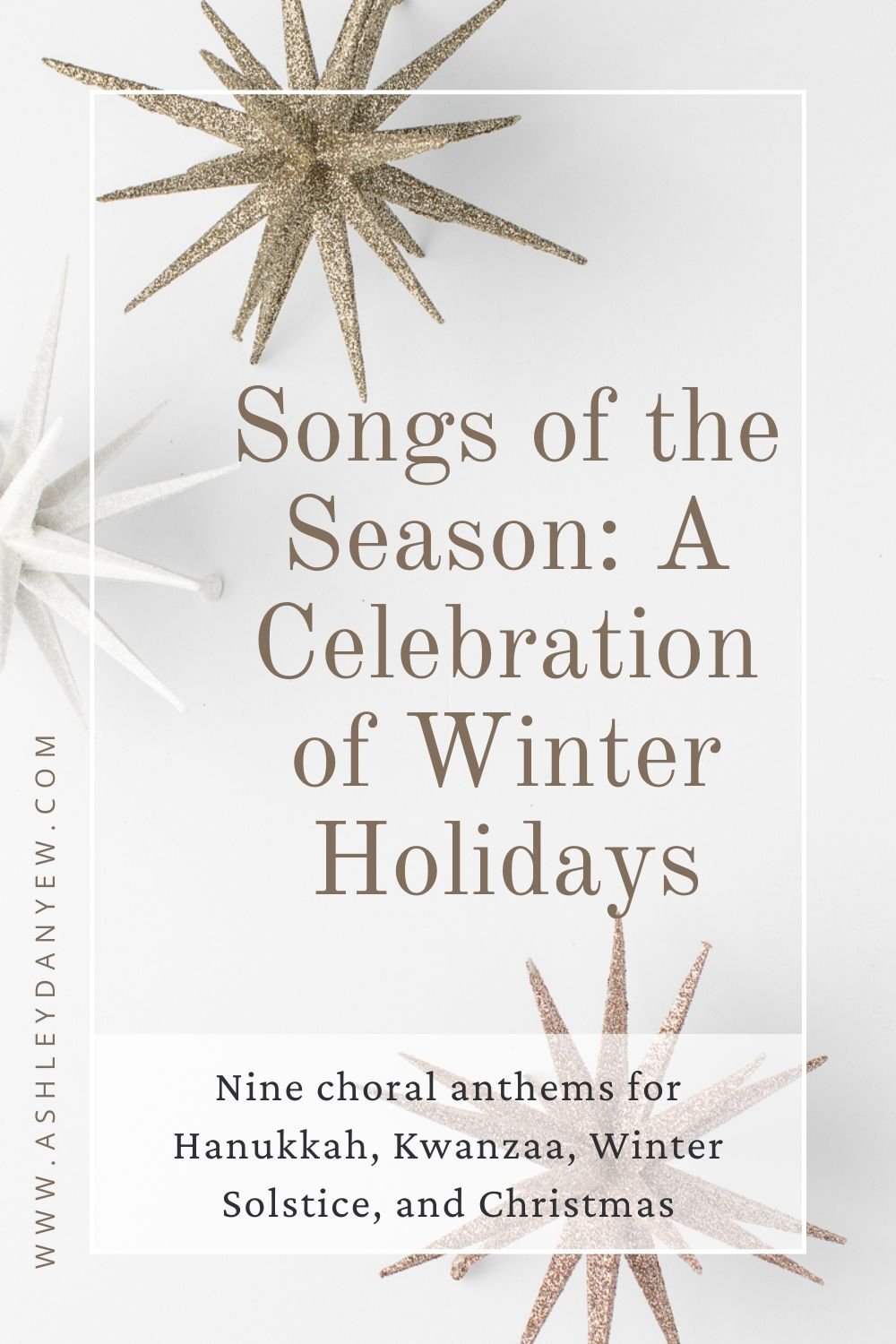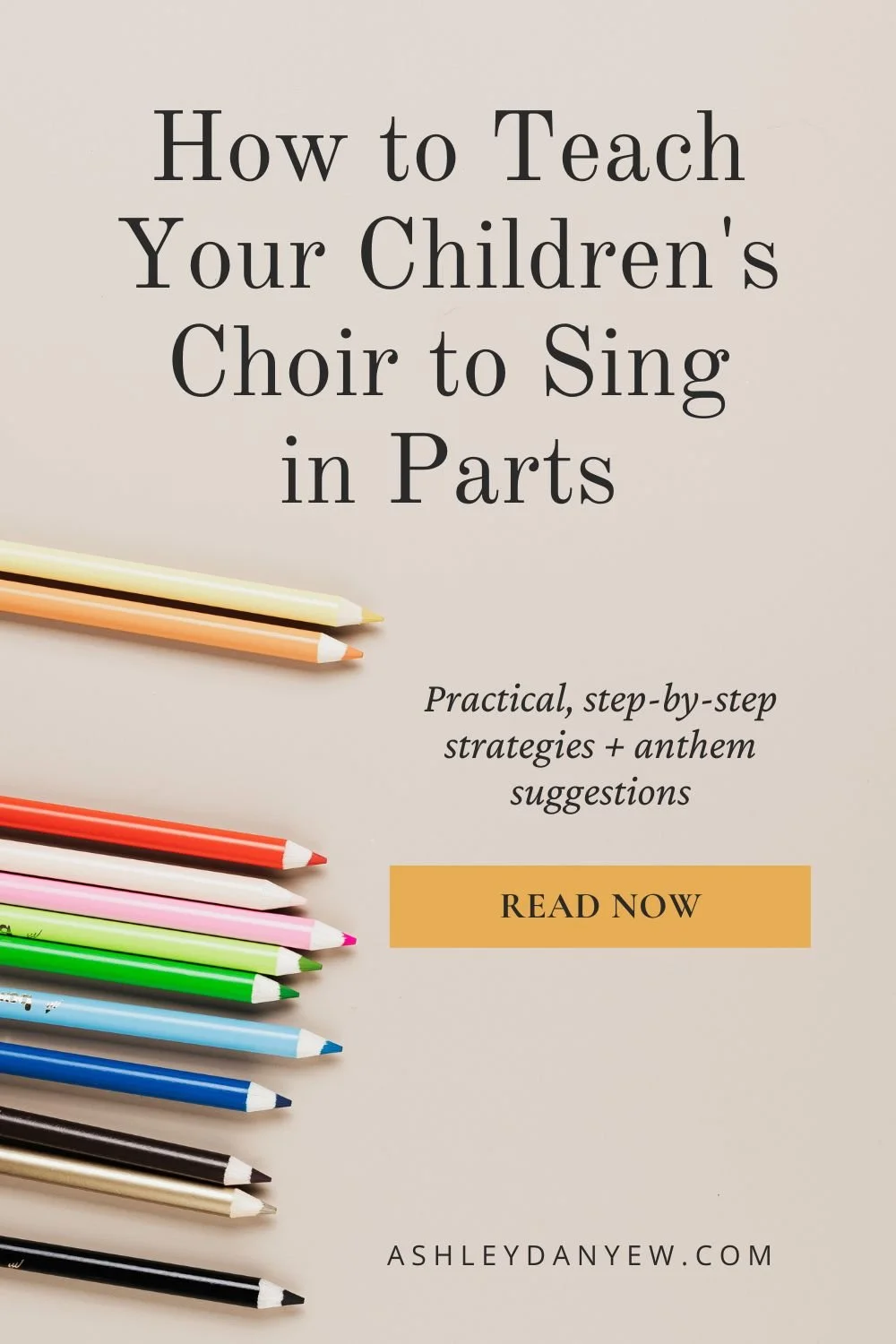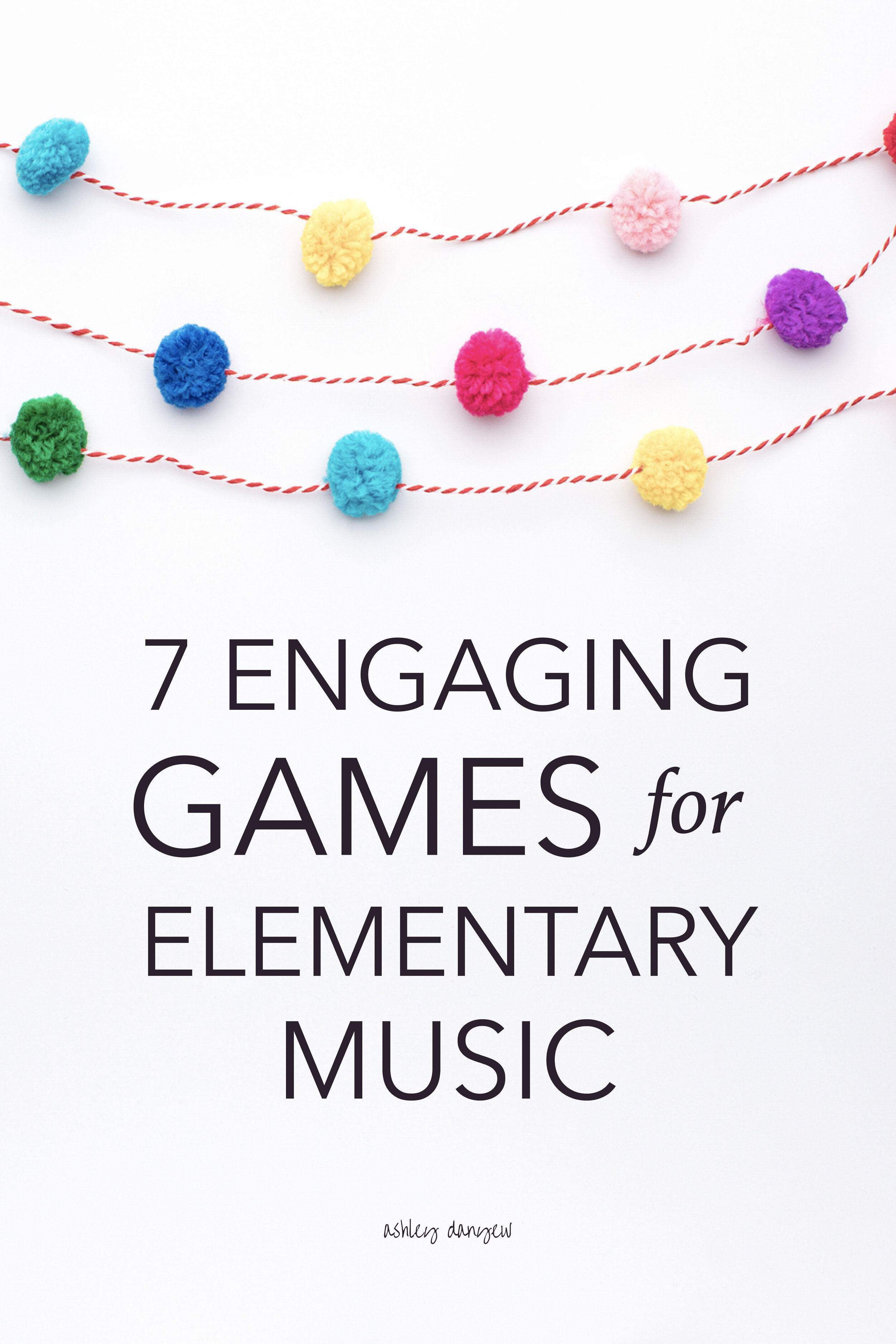A few years ago, I put together a list of 15 singing games for children’s choir. Today, I’m writing a follow-up post to share 15 more singing games you can use with your children’s choir and in your elementary music classes.
In the book, How We Learn: The Surprising Truth About When, Where, and How It Happens, Benedict Carey stated, “Games are the best learning tool.”
It’s true, isn’t it? Games often have a way of teaching us something new without us realizing we are learning. We’re concentrating on the rules, listening, observing, interacting, and in the end, playing.
“Games are the best learning tool.”
Learning is simply embedded in the process.
Singing games and folk dances are a wonderful way to create rich musical experiences for the children you teach, to introduce a new musical skill or concept, build musicianship, develop confidence, cultivate the singing voice, and support the development of rhythmic understanding and the ability to keep a steady beat.
Hopefully, you’ll find a few new games you can add to your repertoire this year. Happy singing!
*Disclosure: I get commissions for purchases made through links in this post.
1. Bluebird
Choose one person to be the bluebird and have everyone else stand in a circle around them, facing inward. Have everyone in the circle hold up their hands, palms touching their neighbor’s palms.
As you sing the first half of the song (mm. 1-8), the child who is the bluebird “flies through the window” by ducking between children in the circle (under their arms), from the inside of the circle to the outside and back again.
In m. 9, have the bluebird tap one child on the shoulder four times (steady beat). Repeat in m. 11 and m. 13. Then, have these three children get in line behind the bluebird to form a bluebird line. Repeat the game, adding three new bluebirds to the line each time until all children are in line. (Source)
2. Apple Tree
Choose two children to be the “apple tree,” holding their hands above their heads to create an arch for others to walk under. Have the remaining children walk under the arch and in a circle as they sing, keeping the steady beat. On the word out, the apple tree quickly lowers its branches and traps an apple.
The child who was caught becomes a new apple tree with another child. (Source)
3. Bonjour, Mes Amis (Hello, My Friends)
Have children form a double circle. The inner circle faces out, the outer circle faces in so each child faces a partner. For phrase 1, have partners shake right hands. For phrase 2, shake left hands. For phrase 3, hold hands and walk in a circle until back in place. For phrase 4, have children in the inner circle clap four times as children in the outer circle take four steps to the left to meet a new partner. (Source)
4. Frère Jacques
Have children form a double circle, facing clockwise, shoulder to shoulder with a partner. As you sing the first line, have children join hands and take eight steps forward. During the second line, have children turn and face their partner. During the third line, have children join both hands with their partner and dance in place. During the final line, have children clap their own hands twice, then clap their partner's hands once. (Source)
5. Clocks and Watches
This is a fun 3-part canon that helps reinforce subdivision of the beat and do, mi, sol.
To begin, sing the song in unison and teach the motions. Have everyone stand in a circle, facing inward:
Line 1 (mm. 1-4): step-touch to the right
Line 2 (mm. 5-8): tiptoe to the left
Line 3 (mm. 9-12): stand in place and move arms in a clockwise circle as you clap the rhythm of the words
Next, try singing a 2-part round by forming two circles. Have one circle begin, then the other circle begins after four measures. Repeat with three circles, singing a 3-part round. (Source)
6. Pass the Pumpkin
Choose a few rhythm pattern cards that your children can read on their own and put them into a pumpkin (or another container).
Have the children sit in a circle and pass the pumpkin as they sing. At the end of the song, the child holding the pumpkin may pull a rhythm pattern card from the pumpkin and clap it (counting silently). The rest of the children should respond by clapping the rhythm back and counting out loud (using a counting method of your choice).
A fun way to make this a little more challenging is to create a rhythmic series at the front of the room with the rhythm patterns chosen in each round. Each time a child pulls a new rhythm pattern from the pumpkin, it gets added to the row, creating a longer rhythmic phrase each time. (Source)
Help your K-5 students learn the language of music and develop their music-reading skills.
Printable, age-appropriate tonal & rhythm pattern card sets for K-5th grade
YOUNGER ELEMENTARY
Includes 88 tonal pattern cards (I, IV, and V7
chord tones in major and minor) + 64 rhythm pattern cards (duple and triple)
OLDER ELEMENTARY
Includes 88 tonal pattern cards (I, IV, and V7
chord patterns in major and minor) + 128
rhythm pattern cards (duple and triple)
7. I’s the By’s
Have children form a double circle. The inner circle faces out, the outer circle faces in so each child faces a partner.
Step 1 (mm. 1-8): have children clap their own hands, clap their partner's right hand, clap their own hands, clap their partner’s left hand, clap their own hands, etc.
Step 2 (mm. 9-12): have children do a gentle hip-bump with their partner four times.
Step 3 (mm. 13-16): have children in the inner circle clap four times as children in the outer circle take four steps to the left to meet a new partner. (Source)
8. The Mill Song
Choose one person to be it. Have everyone else find a partner and walk around in a circle as thy sing. Have the person who’s it stand in the middle of the circle. At the end of the song (or at any time, if you want to play more of a musical-chair-style game), the person who’s it calls out, “corn” or “flour” and everyone has to scramble to find a new partner. The person left without a partner is it for the next round.
9. On a Mountain
As everyone sings the first half of the song, two students swing the jump rope while one student jumps. At the lyrics, “jump in my ___” the child in the middle sings the name of a student. Everyone else echoes the next “jump out my ____” with the name of the child leaving the jump rope game. The new student called jumps in, the old student jumps out, and the game begins again. (Source)
10. Bow, Wow, Wow
Have children stand in a circle and find a partner by turning to face the person next to them. Have each pair perform the following motions as they sing:
m. 1 - Stomp feet three times (right, left, right)
m. 2 - Shake finger at partner in steady beat
m. 3 - Join hands and quickly trade places
m. 4 - Stomp three times, then turn around and face a new partner (source)
11. Doggie, Doggie, Where’s Your Bone?
Choose one child to be the “dog.” Have them stand at the front of the room, cover their eyes, and face away from the group. Secretly give a bone to one child to hide behind their back.
Have all children sing the main part of the song. Have the dog sing, “Who stole my bone?” and the person with the bone answer, “I stole your bone.” (Great opportunity for solo-singing!).
At this point, the dog turns around to face the group. Everyone should have their hands behind their backs so the dog cannot see who has the bone. Instead, the dog should guess who sang the response and is hiding the bone. (Source)
12. Al Citron
Have children sit in a circle. Place a small stone in front of each person. As they sing, have children pass stones to the right on the downbeats and pick up stones on the off-beats. In the last two measures, tap the stone to the right, then tap it in front and release it. (Source)
Variation: Have children pass stones (or another small object) to the left (clockwise), keeping a steady beat. At the word “triki,” switch and have them pass to the right. Those who make a mistake are out. (source)
13. Lucy Locket
Great for teaching dynamic control!
Choose one child to be Lucy and send them out of the room for a moment. Hide a small pocketbook (could be a flat cutout version) somewhere in the room. Invite Lucy to come back in and search for the pocketbook as everyone sings the song. To give Lucy a clue, have everyone sing softly when she’s far away from the pocketbook and gradually get louder as she gets closer. (Source)
14. Tideo
Have children form a double circle. The inner circle faces out, the outer circle faces in so each child faces a partner.
Step 1 (mm. 1-6): children in the outer circle step-touch clockwise to the steady beat (six steps).
Step 2 (mm. 7-8): children face new partner in inner circle and both children pat the sixteenth notes (“jingle at the”) on their legs, clap the eighth notes (“win-dow ti-de-”) and clap their partner’s hands for the quarter note (“o”).
Step 3 (mm. 9-10): children lock right arms and make a half-circle, switching places.
Step 4 (mm. 11-12): children pat the sixteenth notes (“jingle at the”) on their legs, clap the eighth notes (“win-dow ti-de-”) and clap their partner’s hands for the quarter note (“o”). (Source)
15. Dinah
Version 1: Have children stand in a circle. Choose one child to stand in the middle and close their eyes. Make a gap in the circle between two children, then turn the child in the middle around three times. While everyone in the circle sings, the child in the middle looks for the gap (with their eyes closed) by listening for a place where no one is singing.
Version 2: Similar to Version 1 except there isn't a gap. Instead, a child is chosen to sing a solo on "Dinah, Dinah.” The child in the middle has to figure out where the soloist is by using his/her sense of hearing (eyes closed, as in Version 1). The soloist can try running away but must stay inside the circle.
Version 3: Have children stand in a circle and do the following motions as they sing:
Step-touch 3x, pat 3x
Step-touch 3x, clap 3x
Step-touch 3x, snap 3x
Step-touch 3x, pat, clap, snap (Source)
Looking for more elementary music games?
Here’s a free eBook.
This eBook features 62+ fun, creative, musical games for children of all ages, including step-by-step directions for how to play each game, plus links to video demonstrations, where applicable. Sign up below to get your copy:
A few more singing game resources
If you’re looking for more inspiration and ideas for incorporating singing games into your teaching, here are a few collections to consider:
Singing Games Children Love, Vol. 1 - a collection of 60 name games, guessing games, acting games, chase games, steady-beat games, hiding games, partner games, and cumulative games.
Singing Games Children Love, Vol. 2 - 50 more singing games, including 'make up an action' games, clapping games (hand jives), stick games, 'add an action' games, movement canons, and choral warm-ups.
Singing Games Children Love, Vol. 3 - over 50 warm-ups and openers, traditional singing games from North America and around the world, clapping games, chase games, passing games, guessing games, and line games.
Singing Games Children Love, Vol. 4 - 40 singing games geared toward grades 3-6, featuring traditional singing games from North America and around the world, movement canons, and rhythm games.
First, We Sing (Songbook 1) - 20 singing games, songs, and rhymes from around the world. Intended for grades 1-5.
First, We Sing (Songbook 2) - 18 singing games, songs, and rhymes from around the world (this volume includes access to digital video demonstrations with a group of 8- to 12-year-old singers). Intended for grades 1-5.
First, We Sing (Songbook 3) - 20 singing games, songs, and rhymes from around the world (this volume includes access to sing-along audio recordings with a group of 8- to 16-year-old singers). Intended for grades 1-5.
Hot Peas & Barley-O - a collection of 31 songs and games from Scotland, including rhymes for skipping rope, counting songs, and ball-bouncing activities. It also comes with digital access to audio recordings and authentic field recordings from the 40s, 50s, and 60s.
I’d love to hear from you:
What are your favorite singing games and activities? Leave a comment below!









































